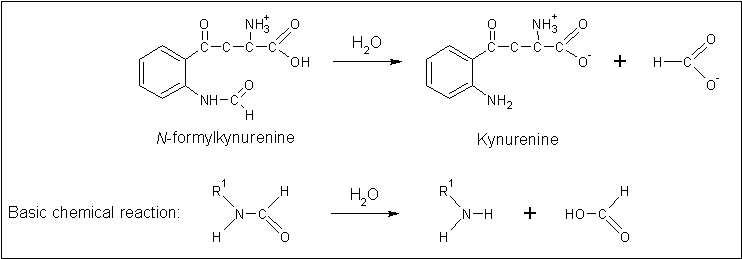Arylformamidase Function: Difference between revisions
Thomasparker (talk | contribs) |
Thomasparker (talk | contribs) |
||
| Line 11: | Line 11: | ||
== Evidence from Similar Structures == | == Evidence from Similar Structures == | ||
A high structural similarity was found between 2pbl and 2c7b, a thermostable carboxylesterase from ... (Z = 24.7, see DALI results). The structure and function of 2c7b has been well characterised (references). From its structure, a catalytic triad has been identified (how?). To elucidate any functional similarity between 2pbl and 2c7b, conservation of the catalytic triad was assessed (see figure ...). Note: the clustalW alignment was found to differ from the alignment provided as part of the DALI results. All three residues were found to be conserved, though H... and E... were found to match is less conserved regions. Thus, it is possible that such conservation is the result of a chance or poor alignment. This might be explained by the poor sequence similarity between 2c7b and 2pdb (16%). | |||
[[Image:2c7b_alignment.png|centre|framed|'''Figure 1:''' ''Conservation of the catalytic triad between 2cb7 and 2pbl.'']] | [[Image:2c7b_alignment.png|centre|framed|'''Figure 1:''' ''Conservation of the catalytic triad between 2cb7 and 2pbl.'']] | ||
[[Image:Carboxylesterase_reaction.gif|centre|framed|'''Figure 2:''' ''The fundamental reaction catalysed by carboxylesterases.'']] | [[Image:Carboxylesterase_reaction.gif|centre|framed|'''Figure 2:''' ''The fundamental reaction catalysed by carboxylesterases.'']] | ||
[[Arylformamidase | Return to the main page...]] | [[Arylformamidase | Return to the main page...]] | ||
Revision as of 09:10, 31 May 2008
Evidence from Similar Sequences
The putative annotation which was initially provided on the basis of... prompted a literature search using the term 'arylformamidase'. Pabarcus et al. (2007) have analysed the function of an arylformamidase present in the liver of Mus musculus. Ironically, from the BLAST results, the most similar sequence to 2pbl for which there was functional information available was the arylformamidase characterised by Pabarcus et al. 2007. Using site-directed mutagenesis, a catalytic triad was identified - S162, D247 and H279. To elucidate any functional similarity between arylformamidase and 2pbl, conservation of the catalytic triad was assessed through a clustalW alignment (see figure ...). Both S162 and H279 were found to be conserved in relatively conserved regions of the alignment whereas D247 had undergone a semi-conserved substitution. These residues correlated to... The residues were located on the tertiary structure of 2pbl and determined to be sufficiently proximal to one another to permit catalysis (see figure...).
Arylformamidase forms part of the tryptophan degradation pathway...
Evidence from Similar Structures
A high structural similarity was found between 2pbl and 2c7b, a thermostable carboxylesterase from ... (Z = 24.7, see DALI results). The structure and function of 2c7b has been well characterised (references). From its structure, a catalytic triad has been identified (how?). To elucidate any functional similarity between 2pbl and 2c7b, conservation of the catalytic triad was assessed (see figure ...). Note: the clustalW alignment was found to differ from the alignment provided as part of the DALI results. All three residues were found to be conserved, though H... and E... were found to match is less conserved regions. Thus, it is possible that such conservation is the result of a chance or poor alignment. This might be explained by the poor sequence similarity between 2c7b and 2pdb (16%).



